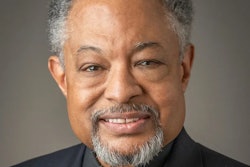When Dr. Bernadine Healy, the renowned A cardiologist who was the first woman to head the National Institutes of Health (NIH), undertook a search in 1991 to hire the first permanent director of NIH’s Office of Research on Women’s Health (ORWH), she did not have to look far to fill the position.
Healy turned to Dr. Vivian W. Pinn, a physician who was then chair of the pathology department at the Howard University School of Medicine in Washington, D.C. The choice by Healy, hailed by those active in the women’s health movement, brought Pinn to the forefront of the nation’s medical research establishment.
Though she had some reservations about working in government, Pinn, who considers herself an activist by temperament, accepted the appointment.
“I did not go looking for this job,” said Pinn. After making the appointment, Healy told reporters that it was Pinn who, as a young medical resident at Massachusetts General Hospital in Boston, once mentored her in 1969 when she was a medical student.
The office, launched in September 1990, had been created in response to the growing outcry by women health advocates and members of Congress that federally supported health research failed to include women in research studies. It was widely acknowledged by the General Accounting Office and the research community that researchers failed to include women in studies because scientists had long considered male biology the standard.
At the NIH, a federal agency operating under the U.S. Department of Health and Human Services and headquartered in Bethesda, Maryland, medical researchers and administrators are charged with suppor tiny scientific research to extend healthy life, and to reduce illness and disability for all Americans.p NIH came under heavy criticism because of its research methodology.
In the late 1980s, for example, it did a huge study of 22,000 physicians — none of whom were women — which established the usefulness of aspirin in preventing heart attack. As a result of the outcry, Healy established the Office of Research on Women’s Health (ORWH) to ensure that federal medical research included women and provided opportunities for women in the medical research field.
“Some people really didn’t believe that it was a legitimate issue,” said Dr. Susan Wood, assistant director of Policy in the U.S. Public Health Service’s Office of Women’s Health. As its incoming director in November 1991, Pinn stepped into a high visibility job whose supporters had great expectations for her. At the time of the ORWH formation, the subject of women’s health exploded into the national consciousness because the media began publicizing the disparities between men’s and women’s health status resulting from the traditional research methodology.
It fell to Pinn to organize ant lead the office to focus on three objectives: strengthen research related to diseases and conditions that affect women; ensure that women are appropriately represented in biomedical and behavioral research studies supported by NIH; and develop opportunities and support for recruitment, retention, re-entry and advancement of women in biomedical careers.
After five years in tile job, Pinn says she is pleased by the progress made by the ORWH. She gets praise for her leadership from officials in the medical research and women’s health community. “I think she’s done a really good job,” Wood said.
“She’s very enthusiastic about the work she’s doing on women’s health,” said Dr. Wilhelmina Leigh, senior research associate at the Joint Center for Political and Economic Studies in Washington, D.C.
What’s Been Done
Under Pinn’s tenure, the ORWH has funded some 353 ongoing NIH-supported grants that meet ORWH’s research agenda. ORWH’s budget has grown from $1.5 million in 1991 to more than $17 million in fiscal year 1997. Pinn said a large part of ORWH funding is used to get new research projects launched and to supplement existing research efforts.
“Our budget doesn’t represent the only funds used to back women’s participation in medical research. Our budget is largely seed money for projects,” she said.
The ORWH has responsibility to monitor the implementation of the NIH Revitalization Act of 1993, according to Pinn. The act mandates that women and minorities be included in all NIH clinical research studies. Wood said it was argued by opponents of the NIFI Revitalization Act that its implementation “was going to cost too much.” One legislator called it “a quota bill,” remembered Wood, who said that Pinn has “moved the office in the direction of ensuring the law is enforced.”
Pinn has won praise from activists and health professionals concerned about the participation of minority women in NIH clinical research.
“She’s been very inclusive of all groups of women. Lots of groups with women in their name focus only on white women. Dr. Pinn does not define women that narrowly,” Leigh said.
Pinn’s office has focused on research into reproductive health, sexually transmitted diseases, the molecular basis for gender differences in diseases, the effect of the environment on women’s health and the prevention and consequences of violence against women.
Personal Commitment to Activism
Fueling Pinn’s lifelong crusade for the inclusion of women and minorities in health care research has been her own personal commitment to social justice. “I consider myself to be an activist. I believe that you can’t just sit back and complain about things. You’ve got to get up and make changes,’ she said.
As a young woman growing up in segregated Lynchburg, Virginia, Pinn saw how doctors misdiagnosed a cancerous tumor in her mother’s leg, which eventually led to her death.
“I identify with the struggle that women have had to make to get proper health care. I saw a doctor talk down to my mother, telling her that she needed orthopedic shoes because he didn’t properly diagnose her condition,” Pinn recollected.
Despite experiencing segregation as a child, Pinn fondly recalls that her family provided her the intellectual and emotional support she needed to pursue a career in medicine. Her parents and grandparents were schoolteachers.
“When I told my folks that I wanted to be a doctor, no one told me that I could not do it. They told me that I could but that I would have to work very hard to achieve my goals,” she said.
During the 1960s, Pinn, who graduated as valedictorian of her high school class in Lynchburg and completed her undergraduate studies at Wellesley College in Massachusetts’ was the only woman and the only African American attending the University of Virginia Medical School.
“It was an interesting time, to say the least,” she said. Pinn completed her post-graduate and residency training in the Boston area where she eventually joined the faculty of the Tufts University School of Medicine, where she stayed from 1970 until 1982.
A winner of several teaching awards while at Tufts, Pinn specialized in pathology with a particular interest in kidney and renal diseases. She also held administrative positions at the school, and managed a clinic. In 1982, Pinn relocated to Washington, D.C., where she became chair of the pathology department at the Howard University Medical School. While at Howard, Pinn served as president of the National Medical Association, a national organization that represents some 20,000 African-American physicians.
The experience of teaching and managing a department at a predominantly Black institution proved to be a gratifying experience, according to Pinn. She said she especially enjoyed mentoring and teaching at Howard, and maintains close contact with her former students.
“I’ve enjoyed teaching and being a role model to students. It comes easily to me because I know how difficult it can be when there’s no one around like yourself to be supportive,” Pinn said.
COPYRIGHT 1996 Cox, Matthews & Associates
© Copyright 2005 by DiverseEducation.com





















